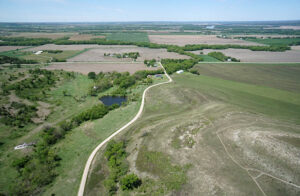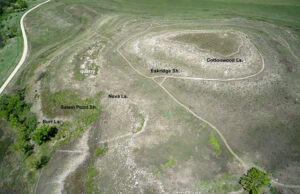
MOUNT MITCHELL’S GEOLOGY
Introduction
Mount Mitchell is an isolated hill that reaches 1210 feet elevation, some 230 feet above the Kansas River valley to the north. This site marks the westernmost appearance of glacial erratics south of the Kansas River valley.
Geology of Mount Mitchell
This location represents a transition from the bedrock terrain of the Flint Hills to the south and west into the glaciated region to the north and east. Bedrock is quite evident and crops out as stone lines on the hillside. The Cottonwood Limestone caps the hill, and the Neva Limestone appears about halfway up the hill. The Neva Limestone was quarried around the sides of the hill and used to construct buildings in Wamego. These abandoned quarries are quite small and presumably date from the late 1800s.
Glacial erratics are scattered around the site and form a pavement with limestone at the top of the hill. These erratics were most likely deposited from icebergs drifting in glacial Lake Manhattan that filled what is now the Kansas River valley directly to the north. The actual limit of the ice sheet lay a short distance to the north and east, thus blocking the local drainage and impounding a lake that filled with meltwater and glacial sediment. Massive influx of icebergs and periodic floods of meltwater carried glacial cobbles and boulders across the lake and deposited them on Mount Mitchell.
Sioux Quartzite is the most abundant type of erratic, transported in the ice sheet from bedrock sources in southwestern Minnesota and eastern South Dakota. Sioux Quartzite is quite resistant to weathering and, so, has collected at the surface since glaciation took place more than half a million years ago. Also present in lesser amounts are cobbles of granite and greenstone. These were derived from outcrops in northern Minnesota or even farther north in Canada.
Jim Aber, Emporia State University Earth Science Department. Author of “Kansas Physiographic Regions: Bird’s-eye Views” Jim Able and Susan W. Aber.


